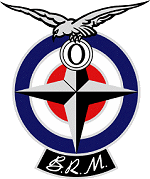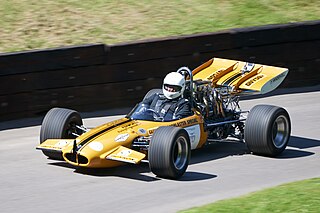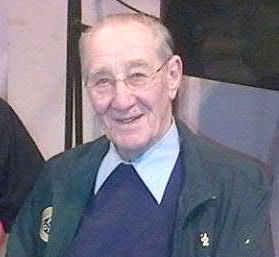
John Michael Hawthorn was a British racing driver. He became the United Kingdom's first Formula One World Champion driver in 1958, whereupon he announced his retirement, having been profoundly affected by the death of his teammate and friend Peter Collins two months earlier in the 1958 German Grand Prix. He died in a road accident three months after retiring.

British Racing Motors (BRM) was a British Formula One motor racing team. Founded in 1945 and based in the market town of Bourne in Lincolnshire, it participated from 1951 to 1977, competing in 197 grands prix and winning seventeen. BRM won the constructors' title in 1962 when its driver Graham Hill became world champion. In 1963, 1964, 1965 and 1971, BRM came second in the constructors' competition.

The 1959 French Grand Prix was a Formula One motor race held at Reims on 5 July 1959. It was race 4 of 9 in the 1959 World Championship of Drivers and race 3 of 8 in the 1959 International Cup for Formula One Manufacturers. It was the 37th French Grand Prix and the twelfth to be held at the Reims highway circuit and the fourth to be held on the longer and faster 8.348 km layout. The race was held over 50 laps of the eight kilometre circuit for a race distance of 417 kilometres.

The 1958 Formula One season was the 12th season of FIA Formula One motor racing. It featured the 9th World Championship of Drivers, the first International Cup for F1 Manufacturers and five non-championship Formula One races. The World Championship was contested over eleven races between 19 January and 19 October 1958. The Indianapolis 500 counted towards the Drivers' Championship but not the Manufacturers' Cup.

Pedro Rodríguez de la Vega was a Mexican racing driver. He began his Formula One career in 1963, won the 1967 South African Grand Prix in a Cooper and the 1970 Belgian Grand Prix in a BRM. He was the older brother of Ricardo Rodríguez.

Joseph Siffert was a Swiss racing driver.

Jean-Pierre Maurice Georges Beltoise was a French Grand Prix motorcycle road racer and Formula One driver who raced for the Matra and BRM teams. He competed in 88 Grands Prix achieving a single victory, at the 1972 Monaco Grand Prix, and a total of eight podium finishes.

Vernon John Schuppan is a retired Australian motor racing driver. Schuppan drove in various categories, participating in Formula One, the Indianapolis 500 and most successfully in sports car racing.

Reginald Parnell was a racing driver and team manager from Derby, England. He participated in seven Formula One World Championship Grands Prix, achieving one podium, and scoring a total of nine championship points.
British Racing Partnership (BRP) was a racing team, and latterly constructor, from the United Kingdom. It was established by Alfred Moss and Ken Gregory – Stirling Moss's father and former manager, respectively – in 1957 to run cars for Stirling, when not under contract with other firms, along with other up-and-coming drivers.

David Hepworth was a British racing driver, who won the British Hill Climb Championship twice, in 1969 and 1971. In the early-mid 1960s Hepworth drove an Austin-Healey 3000 fitted with a Chevrolet engine in both rallies and circuit racing, but by 1968 he was driving a Hepworth-Oldsmobile; in this he won a Formula Libre race at Croft late in that season.
Formula One sponsorship liveries have been used since the 1968 season. Before the arrival of sponsorship liveries in 1968 the nationality of the team determined the colour of a car entered by the team, e.g. cars entered by Italian teams were rosso corsa red, cars entered by French teams were bleu de France blue, and cars entered by British teams were British racing green. Major sponsors such as BP, Shell, and Firestone had pulled out of the sport ahead of this season, prompting the Fédération Internationale de l'Automobile to allow unrestricted sponsorship.
Four-wheel drive (4WD) has only been tried a handful of times in Formula One. In the World Championship era since 1950, only eight such cars are known to have been built.

The BRM P67 was an experimental Formula One car, designed by Tony Rudd and built by the British Racing Motors team in Bourne, Lincolnshire, England, for the 1964 Formula One season.

The BRM P207 was a Formula One racing car, designed by Len Terry and constructed by British Racing Motors, which raced in the 1977 Formula One season. It was powered by a 3.0-litre V12 engine, with a claimed output of 488bhp. London-based Swiss watchmakers Rotary Watches provided sponsorship money. The car failed to score any points during the season. The team made a total of nine entries during the season, but only qualified in one instance, at the 1977 Brazilian Grand Prix. Driven by Larry Perkins, the car retired on lap one due to overheating. Its qualifying time was six seconds slower than that of the second-to-last starter. One British journalist in Brazil exclaimed that he was ashamed of being British. The car failed to appear at the season opening Argentine Grand Prix because it was too wide to fit in the hold of the aircraft that was going to transport it to South America.

The 19th International Gold Cup was a non-championship Formula One race, which was held on the Oulton Park circuit, located near Tarporley, Cheshire, England on 29 May 1972.

The Cooper T86 was a Formula One racing car built by Cooper and first raced in 1967. B and C specification cars were also built to accommodate different engines, but the car could not revive Cooper's fortunes and this type represents the last Formula One chassis built and raced by the former champion team.

Leonard E. Terry was an English racing car designer and engineer, known for his work with Lotus, BRM and Eagle. He also designed chassis for many other teams, including ERA and Aston Martin and produced his own car in which he competed.
Michael Roy Pilbeam is a British motorsport designer and engineer known for his work with BRM, Lotus, Surtees and his own company, Pilbeam Racing Designs. An early design was the experimental four wheel drive Formula One BRM P67 of 1964. As of 2014, Pilbeam's company continued to produce hillclimb cars and sports prototype chassis for endurance racing.
The BRM Hepworth GB-1 was a British sports prototype race car, designed, developed, and built by British constructor BRM, for the North American Can-Am sports car racing series. It was crashed during practice testing at Riverside in 1980, and never raced. It was itself based on the unraced BRM P230 Formula One car.













